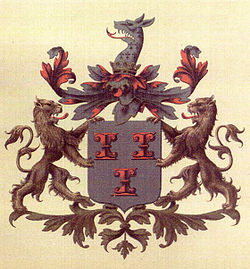
Van Zuylen van Nijevelt
Encyclopedia

Nobility
Nobility is a social class which possesses more acknowledged privileges or eminence than members of most other classes in a society, membership therein typically being hereditary. The privileges associated with nobility may constitute substantial advantages over or relative to non-nobles, or may be...
family from the region of Rotterdam
Rotterdam
Rotterdam is the second-largest city in the Netherlands and one of the largest ports in the world. Starting as a dam on the Rotte river, Rotterdam has grown into a major international commercial centre...
, town and region where several members of the family played a significant role. The head of the family is the Count
Count
A count or countess is an aristocratic nobleman in European countries. The word count came into English from the French comte, itself from Latin comes—in its accusative comitem—meaning "companion", and later "companion of the emperor, delegate of the emperor". The adjective form of the word is...
van Zuylen van Nijevelt; the rest of the family bears the title baron
Baron
Baron is a title of nobility. The word baron comes from Old French baron, itself from Old High German and Latin baro meaning " man, warrior"; it merged with cognate Old English beorn meaning "nobleman"...
or baroness.
This family must not be confused with the old noble family from Utrecht, Van Zuylen van Nievelt
Van Zuylen van Nievelt
Van Zuylen van Nievelt is an old noble Dutch family originating from Utrecht. The family became extinct in 1947 as far as the Dutch descendants are concerned. In the seventeenth century, a branch settled in the southern Netherlands and still continues under the name van Zuylen van Nyevelt...
Origins
During the 19th C. members of this family tried to prove that they were descendants of the Utrecht noble family. This has later been found impossible to prove.Their genealogy starts with a merchant in hosiery trade Van Zuylen. Later they added 'Van Nijevelt' at the time when they had become affluent and accomplished important duties in Rotterdam.
Philip Julius van Zuylen van Nijevelt, senator, was made comte de l'Empire dd. 17 maart 1811. Several of his brothers were made baron de l'Empire in 1813 (not formally confirmed).
Under the United kingdom of the Netherlands, several royal decrees, between 1815-1822, confirmed the noble status of the family. In 1822 the chief of the family was made a count and all other members baron and baroness.
Personalities
- mr. Jacob van Zuylen van Nijevelt (1699-1753), married in 1732 Aletta Johanna Timmers (1707-1775)
- mr. Jacob van Zuylen van Nijevelt (1739-1805), administrator of Rotterdam 1766-1805
- Jan Adriaan van Zuylen van Nijevelt (1776-1840), province governor.
- Arnout van Zuylen van Nijevelt (1780-1835), member of the reunion of notable citizens
- Jacob Pieter Pompejus van Zuylen van Nijevelt (1816-1890), prime minister
- Hugo van Zuylen van Nijevelt (1781-1853), minister.
- Philip Julius van Zuylen van Nijevelt (1743-1826), gouvernor of Amsterdam.
- Pieter Hendrik van Zuylen van Nijevelt (1782-1825), commander of Limburg
- Julius van Zuylen van Nijevelt (1819-1894), prime minister
- Robert van Zuylen van Nijevelt (1859-1911), mayor of Wassenaar.
- Philip Jules graaf van Zuylen van Nijevelt (1898-1940)
- Count Hugo Robert Johan van Zuylen van Nijevelt (1929), founder of Duinrell
- Philip van Zuylen van Nijevelt (1962), CEO Duinrell
- Roderick van Zuylen van Nijevelt (1964), CEO Duinrell.
Arms
The family has canting armsCanting arms
Canting arms are heraldic bearings that represent the bearer's name in a visual pun or rebus. The term cant came into the English language from Anglo-Norman cant, meaning song or singing, from Latin cantāre, and English cognates include canticle, chant, accent, incantation and recant.Canting arms –...
: zuil is the Dutch word for column
Column
A column or pillar in architecture and structural engineering is a vertical structural element that transmits, through compression, the weight of the structure above to other structural elements below. For the purpose of wind or earthquake engineering, columns may be designed to resist lateral forces...
. Hence, the coat of arm depicts three columns. It seerms to have been copied from the arms of the van Zuylen van Nievelt family from Utrecht.
Literature
- H. Obreen-La maison de Zuylen dans l'histoire des Pays-Bas, (Tongerloo, 1933).
- D.G. van Epen-Het geslacht van Zuylen van Nijevelt, ('s-Gravenhage, 1904).

